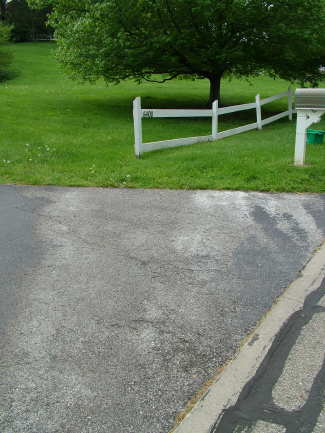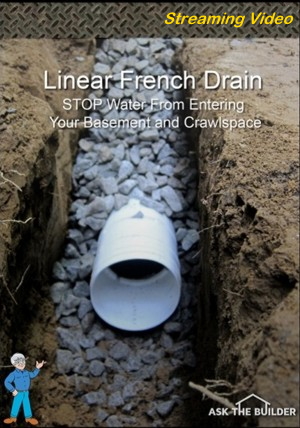French Drain
DEAR TIM: We are demolishing a house built in 1923, and intend to build a larger home on the site. There is an active spring on the property, and the old house had water and dampness problems.
What can we do to ensure the spring will not cause problems as we build, and after we inhabit the home? Will the spring cause soil compaction issues and/or soil stability issues over time?
Barry P., Bethesda, MD
DEAR BARRY: Water is the nemesis of many a homeowner. It doesn't make any difference where your home is located, as houses built on slabs, with basements, on flat ground or sloped land can all have problems caused by surface water that eventually becomes spring water. Underground springs are a special situation that affects certain building lots, but with a little extra work, the spring on your lot can be rendered harmless. If you install a french drain on the lot, the spring can be controlled with ease.

Look at the water from the active spring covering the driveway. It hasn't rained for nearly two days, yet water still is flowing out of the soil. The hill continues up behind the house for several hundred feet. Thousands of gallons of water are in the soil, working their way toward this spring. PHOTO CREDIT: Tim Carter
Freshwater springs are a desired item for some land owners, but they are feared by others. If you own a larger piece of land and are lucky enough to have a spring above your home, you can actually pipe the water to the home using gravity as the delivery method. The spring water can be used for washing clothes, watering indoor plants, and irrigating outdoor landscaping or gardens if necessary. There are countless uses for pure and natural spring water. If you have it tested regularly, it may be excellent drinking water. You may want to consider capturing your spring water to use for some purpose.
The water that is issuing forth from the spring started as rainwater. Rain enters soil and/or flows across bedrock as it starts its journey back to oceans or lakes. The local geology of an area determines whether springs will be plentiful or non-existent. In areas where the subsoil has a clay component or bedrock close to the surface, the rainwater that soaks into the soil starts to find it more difficult to go down and actually starts to move sideways along the top of the thick clay subsoil or bedrock ledge.
If the surface topography of the land is such where the shape of the land is like a funnel, the flow of the water in the soil can be concentrated to a single point. It is not uncommon for this water to create a visible spring where the water flows out of the soil onto the surface of the land. In other areas, the flow of the spring water stays hidden below the surface of the ground.
There are any number of ways to deal with spring water as you build a new home. One method is to dig a trench on the uphill side of the foundation excavation so you can intercept the water before it becomes a problem. The trench can wrap around the jobsite and the water can flow past the construction site. I prefer this method over digging a pit for the water. The pit method requires periodic pumping. Pumps can fail, and when this happens, the excavation can become flooded.
The spring should not cause any problems with the soil stability of your new home. If the existing house built in 1923 had no structural or foundation problems, this tells you the spring is a shallow one and the soil is probably strong enough for your new home. If you have any doubt whatsoever, I suggest you hire a geotechnical soil engineer to look at the soil once the foundation excavation for your new home is complete.

This light-colored area on the driveway was caused by water that flows from an active spring. PHOTO CREDIT: Tim Carter
Using soil maps and possibly samples of the deep soil inside the excavation, the engineer may give the site a passing grade. If he feels there may be a problem, the engineer may suggest piers or some other system to stabilize the new foundation.
The spring water will not be a problem for your new home if you install a top-quality waterproofing system on the outside of your new foundation. There are many different systems, and the one I used 20 years ago still keeps my basement bone dry. If you are using a high-quality builder, he will know one or more great systems to use. One key to keeping your basement dry is backfilling around the house with plenty of clean, washed gravel.
Another necessary component of a foundation waterproofing system is a perforated drain pipe that is 6 inches in diameter placed at the bottom of the excavation next to the concrete footer that supports your foundation. This drain pipe must surround the house and be extended to a low spot on your property where the spring water can drain by gravity. If your lot is too level, preventing the pipe from exiting at grade level, you will have to install an interior or exterior sump pit, and pump the water out to keep your basement dry.
It is nearly impossible to stop the flow of spring water. The best practice is to capture the water and divert it around your home. Water that is flowing underground wants to take the path of least resistance. So make it easy for the water to bypass your basement.
To do this, use plenty of 1-inch diameter or larger rounded washed gravel. Water flows through this with little or no effort. Water loves to travel through rounded washed gravel and struggles to pass through soil, especially soil that has a clay component.
If purchasing a new lot for a home, always try to buy a lot that has natural slope to it. This slope will come in handy when dealing with groundwater of any type.
Read about Kathy's concerns over a wet lot in my March 15, 2011 Newsletter.
Column 619

3 Responses to French Drain